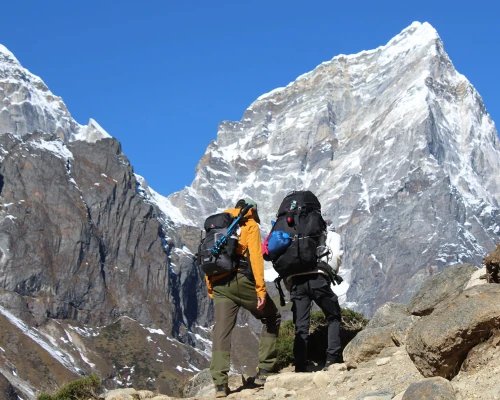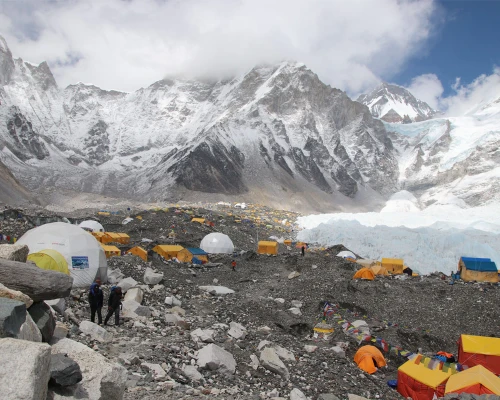The Everest Base Camp with Island Peak expedition is a journey that combines the classic trek to Everest Base Camp with peak climbing in the Himalayas. Starting with a flight to Lukla, the journey takes you through colorful Sherpa villages, ancient monasteries, and up to Everest Base Camp and Kala Patthar.
From there, the adventure continues to Island Peak Base Camp, leading to a rewarding summit at 6,189 meters. Along the way, you will experience diverse landscapes, local culture, and breathtaking views that make this trip more than just a trek; it's a life-changing journey.
As the journey progresses beyond Everest Base Camp, trekkers walk across the dramatic Khumbu Glacier, carefully going through icy terrain with the help of a guide. Passing the enchanting Khumbu Icefall offers a close look at towering ice towers and deep cracks that climbers face on their way to Everest.
Later, while approaching Island Peak, you will trek through the Imja Glacier and rope up to cross snowy fields and a steep final ice wall, a thrilling experience that blends mountaineering with surreal Himalayan beauty.
Why Choose the Everest Base Camp with Island Peak Trek?
Choosing the Everest Base Camp with Island Peak Trek means adding real adventure to an already iconic journey. Compared to Mera or Lobuche, Island Peak is more beginner-friendly yet still offers a serious mountaineering thrill.
It's the perfect next step for trekkers wanting more than just a trail. Climbing Island Peak brings not just a sense of achievement but unforgettable views and a deeper connection to the power of the Himalayas. The trail is challenging and rewarding at the same time. This makes it one of the most thrilling trekking routes in Nepal.
Along the route, you will witness breathtaking vistas of Everest, Lhotse, Nuptse, Ama Dablam, Makalu, and Baruntse.These towering Himalayan giants leave you in a state of awe, especially from Kala Patthar and the Island Peak summit.
You will pass sacred sites like Tengboche Monastery, where monks chant against a dramatic mountain backdrop, adding a spiritual essence to your trek. This fusion of raw adventure and deep cultural involvement makes the experience rewarding.
Overview of the Route
The Everest Base Camp with an island peak expedition starts in Kathmandu, the short scenic flight takes you to Lukla, the gateway to the Everest Region. From here, the trek curves through vibrant Sherpa villages like Namche Bazar, Tengboche, and Dingboche.
You will trek up to Everest Base Camp and Kala Patthar before heading towards Chukhung and Island Peak Base Camp. The route beautifully blends cultural trekking with alpine climbing, which makes it one of the most enriching adventures in the Himalayas.
Where are the starting and Ending Points?
Your journey begins in Kathmandu with a flight to Lukla, one of the most exciting airports in the world. From Lukla, the trek progresses through the heart of the Khumbu region and eventually circles back after the Island Peak summit.
After the climb, you descend back to Lukla, then fly to Kathmandu, where many trekkers relax before flying home. It's easy to reach Kathmandu via international flights, making this itinerary smooth from start to finish.
Trek Duration, Distance, and Itinerary Summary
The Everest Base Camp with Island Peak Itinerary usually spans 18-21 days, depending on acclimatization needs. In total, you will cover about 120-130 km on foot, including trekking and climbing phases.
The itinerary includes rest days in Namche and Dingboche for acclimatization. It's a time at Everest Base Camp, a summit attempt at Island Peak (6,189 meters), and a steady descent back to Lukla. It’s a well-balanced trek that blends challenge with thoughtful pacing. Acclimatization is a must for treks like these, which demand high-altitude ascent. We advise you to listen to your body and walk at your own pace.
What is the trek Altitude Profile?
Throughout the Everest Base Camp with Island Peak Expedition, you will gradually ascend from Lukla (2,860 meters) to higher elevations like Namche Bazar (3,440 meters) and Dingboche (4,410 meters), giving your body time to adjust to the altitude.
The trek reaches Everest Base Camp (5,364m) and continues to Chukhung (4,730 m) before the final ascent to Island Peak Summit (6,189 m), the highest point in the journey. The lowest point is Lukla, which has a total elevation gain.
Altitude plays a major role in each phase, especially after Namche. That’s why the Everest Base Camp with Island Peak itinerary is mentioned in this blog, so that it will be easier for you to break down the cost and know exactly what we will be doing on the trek. Keep on reading to know better.
Difficulty Level and Terrain during Everest Base Camp with Island Peak
The Everest Base Camp with Island Peak Trek is moderately difficult in the trekking portion. It involves long walking days over rocky trails without suspension bridges. As you gain altitude, stamina and mental endurance become key.
Climbing ISland Peak adds a mountaineering challenge. The route includes glacier crossings, fixed rope sections, and an ice wall near the summit. It’s not technical but requires the use of gearlike crampons, an ice axe, and a harness.
This trek is ideal for fit trekkers with prior high-altitude experience and strong preparation. While you don't need to be a pro climber, some basic training for the Island Peak Climb with the Everest Base Camp Trek goes a long way. It would be great if you started exercising months before the trek begins. This increases your physical stamina and trekking consistency.

.webp)
.webp)
.webp)
.webp)

.webp)
.webp)
.webp)
.webp)
.webp)
.webp)

-1.webp)

.webp)
.webp)